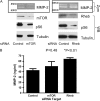Rapamycin-insensitive up-regulation of MMP2 and other genes in tuberous sclerosis complex 2-deficient lymphangioleiomyomatosis-like cells
- PMID: 19395678
- PMCID: PMC2822984
- DOI: 10.1165/rcmb.2009-0050OC
Rapamycin-insensitive up-regulation of MMP2 and other genes in tuberous sclerosis complex 2-deficient lymphangioleiomyomatosis-like cells
Abstract
Increased matrix metalloproteinase (MMP) activity has been implicated in the pathogenesis of lymphangioleiomyomatosis (LAM). The objective of this study was to investigate how tuberous sclerosis complex (TSC) 1 or TSC2 deficiency alters MMP expression and regulation. We studied immortalized cells that lack TSC2 derived from an angiomyolipoma of a patient with LAM, a TSC2 addback derivative, and murine embryonic fibroblast cells that lack Tsc1 or -2 and respective controls. Global gene expression analysis was performed in the angiomyolipoma and derivative cell lines. MMP levels in the conditioned media from these cells were analyzed by zymography and ELISA. We found increased MMP-2 expression in cells lacking TSC1/TSC2 compared with their respective controls by zymography. MMP-2 overproduction by these cells was not affected by rapamycin treatment. Gene expression analysis confirmed increased MMP-2 gene expression that was not affected by rapamycin. Furthermore, multiple other genes were found to be overexpressed in rapamycin-treated TSC2-deficient cells compared with TSC2(+) cells. We conclude that TSC1/TSC2 deficiency leads to MMP-2 overproduction that is rapamycin-insensitive, and that several genes exhibit similar patterns, suggesting that TSC1/TSC2-dependent, but mammalian target of rapamycin-independent, pathways may be involved in the pathogenesis of LAM.
Figures



Similar articles
-
Non-canonical functions of the tuberous sclerosis complex-Rheb signalling axis.EMBO Mol Med. 2011 Apr;3(4):189-200. doi: 10.1002/emmm.201100131. Epub 2011 Mar 16. EMBO Mol Med. 2011. PMID: 21412983 Free PMC article. Review.
-
Urokinase-type plasminogen activator (uPA) is critical for progression of tuberous sclerosis complex 2 (TSC2)-deficient tumors.J Biol Chem. 2017 Dec 15;292(50):20528-20543. doi: 10.1074/jbc.M117.799593. Epub 2017 Sep 27. J Biol Chem. 2017. PMID: 28972182 Free PMC article.
-
Rapamycin-insensitive up-regulation of adipocyte phospholipase A2 in tuberous sclerosis and lymphangioleiomyomatosis.PLoS One. 2014 Oct 27;9(10):e104809. doi: 10.1371/journal.pone.0104809. eCollection 2014. PLoS One. 2014. PMID: 25347447 Free PMC article.
-
Analysis of gene expression array in TSC2-deficient AML cells reveals IRF7 as a pivotal factor in the Rheb/mTOR pathway.Cell Death Dis. 2014 Dec 4;5(12):e1557. doi: 10.1038/cddis.2014.502. Cell Death Dis. 2014. PMID: 25476905 Free PMC article.
-
The TSC1-TSC2 complex: a molecular switchboard controlling cell growth.Biochem J. 2008 Jun 1;412(2):179-90. doi: 10.1042/BJ20080281. Biochem J. 2008. PMID: 18466115 Free PMC article. Review.
Cited by
-
Non-canonical functions of the tuberous sclerosis complex-Rheb signalling axis.EMBO Mol Med. 2011 Apr;3(4):189-200. doi: 10.1002/emmm.201100131. Epub 2011 Mar 16. EMBO Mol Med. 2011. PMID: 21412983 Free PMC article. Review.
-
TSC1/TSC2 signaling in the CNS.FEBS Lett. 2011 Apr 6;585(7):973-80. doi: 10.1016/j.febslet.2011.02.001. Epub 2011 Feb 15. FEBS Lett. 2011. PMID: 21329690 Free PMC article. Review.
-
Evidence Supporting a Lymphatic Endothelium Origin for Angiomyolipoma, a TSC2(-) Tumor Related to Lymphangioleiomyomatosis.Am J Pathol. 2016 Jul;186(7):1825-1836. doi: 10.1016/j.ajpath.2016.03.009. Epub 2016 Jun 8. Am J Pathol. 2016. PMID: 27289491 Free PMC article.
-
Angiotensin-converting enzyme inhibitors may affect pulmonary function in lymphangioleiomyomatosis.JCI Insight. 2019 Mar 7;4(5):e126703. doi: 10.1172/jci.insight.126703. eCollection 2019 Mar 7. JCI Insight. 2019. PMID: 30843885 Free PMC article.
-
Novel developments in the study of estrogen in the pathogenesis and therapeutic intervention of lymphangioleiomyomatosis.Orphanet J Rare Dis. 2024 Jun 14;19(1):236. doi: 10.1186/s13023-024-03239-1. Orphanet J Rare Dis. 2024. PMID: 38877584 Free PMC article. Review.
References
-
- McCormack FX. Lymphangioleiomyomatosis: a clinical update. Chest 2008;133:507–516. - PubMed
-
- Kumasaka T, Seyama K, Mitani K, Sato T, Souma S, Kondo T, Hayashi S, Minami M, Uekusa T, Fukuchi Y, et al. Lymphangiogenesis in lymphangioleiomyomatosis: its implication in the progression of lymphangioleiomyomatosis. Am J Surg Pathol 2004;28:1007–1016. - PubMed
Publication types
MeSH terms
Substances
Grants and funding
LinkOut - more resources
Full Text Sources
Other Literature Sources
Medical
Molecular Biology Databases
Miscellaneous

